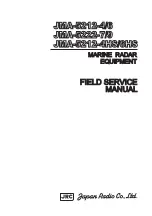
10.Appendix
10-8
Alert priority and Alert state can be null fields.
2) The sequential message identifier relates all sentences that belong to a group of multiple
sentences (i.e. message). Multiple sentences with the same sequential message identifier,
make up one message.
3) Time should represent the last time the data within the alert message has changed. For
example changing the alert text by in-/decrementing a contained counter or count down
should cause a revision of alert message and a new time. Time is an optional field. The
time-field is additional information about when this happened and not used for decision
making. There is no mandatory requirement for time synchronization between the
equipment. It should by either a null field (if not used) or UTC (if used). Sender is allowed to
use all alternatives defined in Table 5 Field type summary. Receiver is allowed to ignore
content of this field. If the receiver does not ignore this field it should support all alternatives
defined in Table 5 Field type summary.
4) The alert category is in compliance with the category definition as described in INS
Performance Standard (IMO MSC.252(83)) and Bridge Alert Management Performance
Standard (IMO MSC.302(87)):
A, Category A: Alerts where information at operator unit directly assigned to the function
generating the alert is necessary, as decision support for the evaluation of the
alert-related condition, e.g. graphical information of danger of collision or
graphical information of danger of grounding.
B, Category B: Alerts where no additional information for decision support is necessary
besides the information which can be presented using alert source and alert
description text.
C, Category C: Alerts that cannot be acknowledged on the bridge but for which information is
required about the status and treatment of the alerts, e.g., certain alerts from
the engine.
5) Alert priority: Emergency Alarm: E, for use with Bridge alert management
Alarm: A
Warning: W
Caution: C
6) The alert state transition is defined in IEC 61924-2:2012, Annex J
active – unacknowledged: V
active – silenced: S
active – acknowledged or active: A
active – responsibility transferred: O
rectified – unacknowledged: U
normal: N
7) Used for proprietary alerts defined by the manufacturer. For standardized alerts this should
be a null field.
8) The alert identifier is unique within a single alert source. The alert identifier is a variable
length integer field of maximum a 7-digit integer. It identifies the type of the alert, e.g. a “lost
target” alert. Standardized alerts use unique alert identifiers described in equipment
standards. Number range 10000-9999999 is reserved for proprietary alerts. Alert Identifier
examples: “001”, “2456789”, “245”
9) The alert instance identifies the current instance of an alert to distinguish alerts of the same
type (Alert identifier) and from the same source (e.g. dangerous target). Alert instance is
maximum a 6-digit integer from 1 to 999999, the number ‘0’ indicates that this sentence is
intended for all alert instances. Except for number ‘0’, the number of alert instance can be
freely defined by the manufacturer as long as it is unique for one type of alert (alert
Summary of Contents for JFE-400
Page 1: ...Echo Sounder INSTRUCTION MANUAL ...
Page 2: ......
Page 19: ...Explanation of Terms xvii Blank Page ...
Page 34: ...2 Control Panel 2 2 Blank Page ...
Page 38: ...3 Display 3 4 Blank Page ...
Page 58: ...4 Operation 4 20 2 HISTORY print mode 3 LOG print mode Depth data and graph ...
Page 80: ...6 Consider Installation 6 6 2 Blank Page ...
Page 84: ...8 Disposal 8 2 Blank Page ...
Page 86: ...9 Specification 9 2 Blank Page ...
Page 102: ...10 Appendix 10 16 Blank Page ...
Page 103: ......











































